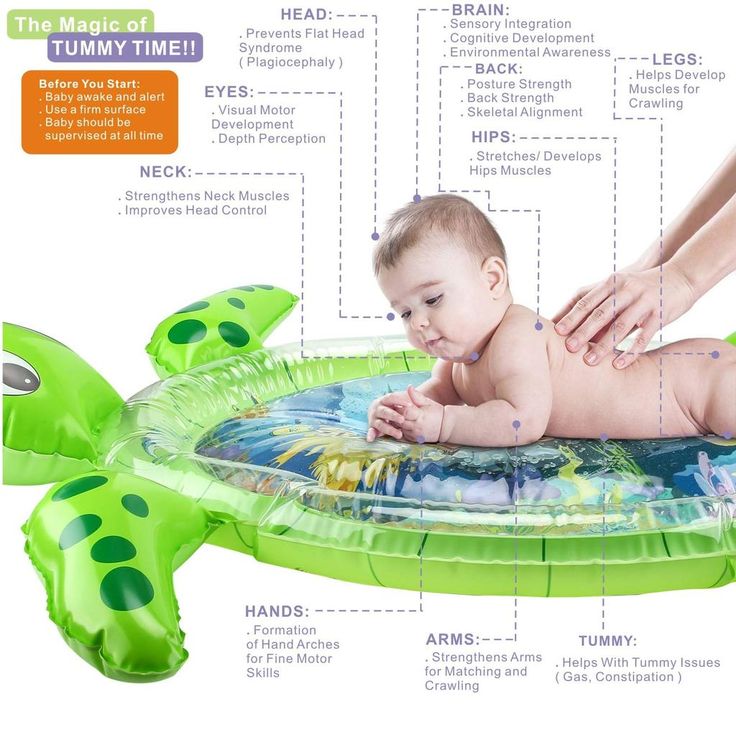Introducing tummy time
When to Start and How to Do It
With all the focus on putting baby to sleep on their back, it’s easy to forget that tummy time is actually pretty important. Though it’s tough to see at first, all those little wiggles and attempts at half-lifts are contributing to baby’s development in major ways, preventing flat spots from forming on the back of their head (a side effect of all that time on their back) and preparing them for a few down-the-road milestones like rolling over and crawling. But if you’re new to this whole parenting gig, you might be wondering what exactly tummy time is and how it works. Don’t worry, we’re here to help with answers to all the questions you didn’t even know you had. So at what age should you start tummy time? And how often does baby need to do it? Read on to learn everything you need to know about the important developmental exercise known as tummy time.
In this article:
What is tummy time?
Benefits of tummy time
When to start tummy time
How long should tummy time last?
How to do tummy time
Tummy time tips
What Is Tummy Time?
When we talk about tummy time, what exactly do we mean? Suffice to say, tummy time is exactly what it sounds like—time that baby spends on their stomach while awake and supervised. Placing baby on their tummy encourages them to lift their head, which helps strengthen their head, neck and shoulder muscles and boost motor skills.
Benefits of Tummy Time
We know, it’s not easy to make baby do an activity they’re less than thrilled about. But trust us, tummy time is worth it. In addition to offering a sweet way for the two of you to bond, there are some major benefits of tummy time:
• Practice for milestones like rolling over, sitting upright and crawling
• Strengthens gross motor skills
• Engages lesser-used muscle groups
• Prevents plagiocephaly (aka flat head syndrome)
• Helps baby master head control
• Alleviates gas pain
• Exposes baby to a different environment
When to Start Tummy Time
At what age should you start tummy time? While there’s no prescription for exactly when to begin practicing tummy time, the American Academy of Pediatrics recommends parents get going on it early. In fact, babies born at full term with no health issues can start tummy time as soon as their first day home from the hospital—so long as you and your newborn are both awake and alert, and you or another caregiver are there to supervise.
Don’t be surprised if baby hates tummy time and those initial attempts are met with some resistance. “Babies usually don’t like it and get cranky about it,” says Michael McKenna, MD, a pediatrician at St. Vincent Medical Group in Zionsville, Indiana. “The first time, they might only be down there for a minute before they start screaming. It’s about getting them used to being in that position. You’ll probably have to start with short sessions and work your way up.”
How Long Should Tummy Time Last?
Now that you know when to start tummy time (the sooner, the better!), you may be wondering how long each practice session should last. A little bit of tummy time actually goes a long way. When it comes to newborn tummy time, aim for two to three sessions a day for three to five minutes at a time, ideally after a nap or diaper change and as part of playtime. “You can stop or take breaks in there if your baby is having a tough time,” says Ashanti Woods, MD, a pediatrician at Mercy Family Care Physicians in Baltimore, Maryland.
As baby gets older and begins to enjoy this “workout,” gradually ramp up the number and duration of tummy time sessions. Aim for around 20 to 30 minutes a day of baby tummy time by the time they’re 3 or 4 months old. Remember, it doesn’t have to happen in one long session. Keep the practice up until baby can roll over on their own, a feat many babies accomplish around 6 or 7 months of age. Even then, you may consider keeping tummy time practice a part of your regular routine; it’ll help them as they start learning to crawl.
How To Do Tummy Time
Like most exercises, tummy time is pretty straightforward. Here’s how to get started:
• Set-up a soft, safe space and lay baby down. A blanket or a tummy time mat on a firm, flat surface works well. The floor is an ideal spot, though you can also lay your infant tummy down on your stomach or chest or across your lap.
• If baby doesn’t respond to tummy time on their own, try to engage them. Seeing your face can be incentive enough for baby to try lifting their head from your body, but McKenna warns that sometimes this plan can backfire. A sleep-deprived new parent (read: all of us!) might be tempted to snooze. Or, if you manage to stay awake, baby might not have incentive to lift their head off of your warm body and they could drift off to sleep.
A sleep-deprived new parent (read: all of us!) might be tempted to snooze. Or, if you manage to stay awake, baby might not have incentive to lift their head off of your warm body and they could drift off to sleep.
See how it goes and how baby responds to tummy time. You may need to play around with positioning. If, say, baby really can’t handle being on their stomach, consider laying them on their side. This AAP-recommended position has baby on a blanket, laying on their side, with a rolled-up towel behind their back and a rolled-up washcloth under their head for support (if needed). Bring both of baby’s arms in front of them and both legs forward, bending their knees for comfort. Be sure to roll them to the alternating side every 10 to 15 minutes.
Tummy Time Tips
In a perfect world, your infant will push up and move around on their own during tummy time. But chances are, they’ll need some sort of stimulation to stay engaged. Here are some tummy time moves and distraction to try:
-
Use special tummy time toys.
 Pull out one or two novel tummy time toys and place them just out of reach, so baby has to extend themselves to grab them. You can also try holding a brightly colored stuffed animal or shaking a rattle near baby’s face to distract them from the task at hand.
Pull out one or two novel tummy time toys and place them just out of reach, so baby has to extend themselves to grab them. You can also try holding a brightly colored stuffed animal or shaking a rattle near baby’s face to distract them from the task at hand. -
Use a mirror. Do you have an unbreakable baby mirror from a playmat or toy? Put this in front of baby’s face. They may enjoy seeing their reflection during tummy time.
-
Get in on the tummy time action. If your little one isn’t happy about exercising alone, you can join the activity. “Lay down there with your baby,” McKenna suggests. “Move their hands around, have them feel new things, read to them or put down different-colored blankets—something to keep it interesting for baby.” You can also enlist a sibling to help entertain baby.
-
Use your body. Tummy time on the floor might not be your baby’s thing for a while. If this is the case, you can use your own body as baby’s personal tummy time mat.
 Place baby across your lap, belly down. Use your hand to rub their back or offer gentle, rhythmic pats. You can also try laying down on your back and placing baby tummy down on your belly.
Place baby across your lap, belly down. Use your hand to rub their back or offer gentle, rhythmic pats. You can also try laying down on your back and placing baby tummy down on your belly. -
Try a football hold. Hold baby like a football, balancing their tummy on your arm with their legs and arms on either side. Be sure to support their back and neck with your other hand. This is a good beginner option for babies who resist any and all tummy time.
-
Prop baby up. If baby doesn’t like being flat on their tummy, you can try propping them with a nursing pillow under their chest at first. This will hopefully get them used to the position, so that you can eventually (and gradually) remove any props. With or without a pillow, remember to always keep an eye on baby while they’re practicing tummy time.
What if baby still hates tummy time? Don’t stress—and don’t give up, Woods advises. “Like many things with children, it’s okay to step back, take a break and come back to tummy time,” he says. “Take a couple of days or a week off, and try again later. You’ll likely see success after you take a breather.” Also consider shortening sessions and spacing tummy time out throughout the day to make the task a little more bearable for baby. A little here and there all add up. “As long as they are doing some [tummy time], it will have some benefit,” McKenna points out.
“Take a couple of days or a week off, and try again later. You’ll likely see success after you take a breather.” Also consider shortening sessions and spacing tummy time out throughout the day to make the task a little more bearable for baby. A little here and there all add up. “As long as they are doing some [tummy time], it will have some benefit,” McKenna points out.
Incorporating tummy time into your daily routine with baby might feel daunting at first—especially if they fight the activity. Don’t put too much pressure on yourself or your little one right away. Gradually, they’ll get used to this position, and you’ll find a few creative ways to squeeze in some practice.
About the experts:
Michael McKenna, MD, a pediatrician at Ascension Medical Group in Zionsville, Indiana. He earned his medical degree at Indiana University School Of Medicine in St., Indianapolis.
Ashanti Woods, MD, a pediatrician at Mercy Family Care Physicians in Baltimore, Maryland. He earned his medical degree from Howard University College of Medicine in Washington, DC.
He earned his medical degree from Howard University College of Medicine in Washington, DC.
Please note: The Bump and the materials and information it contains are not intended to, and do not constitute, medical or other health advice or diagnosis and should not be used as such. You should always consult with a qualified physician or health professional about your specific circumstances.
Plus, more from The Bump:
What You Need to Know About Baby Growth Spurts
When Do Babies Start Talking?
Why Babies Get Clingy—And How to Cope
When to Start and How to Do It
With all the focus on putting baby to sleep on their back, it’s easy to forget that tummy time is actually pretty important. Though it’s tough to see at first, all those little wiggles and attempts at half-lifts are contributing to baby’s development in major ways, preventing flat spots from forming on the back of their head (a side effect of all that time on their back) and preparing them for a few down-the-road milestones like rolling over and crawling. But if you’re new to this whole parenting gig, you might be wondering what exactly tummy time is and how it works. Don’t worry, we’re here to help with answers to all the questions you didn’t even know you had. So at what age should you start tummy time? And how often does baby need to do it? Read on to learn everything you need to know about the important developmental exercise known as tummy time.
But if you’re new to this whole parenting gig, you might be wondering what exactly tummy time is and how it works. Don’t worry, we’re here to help with answers to all the questions you didn’t even know you had. So at what age should you start tummy time? And how often does baby need to do it? Read on to learn everything you need to know about the important developmental exercise known as tummy time.
In this article:
What is tummy time?
Benefits of tummy time
When to start tummy time
How long should tummy time last?
How to do tummy time
Tummy time tips
What Is Tummy Time?
When we talk about tummy time, what exactly do we mean? Suffice to say, tummy time is exactly what it sounds like—time that baby spends on their stomach while awake and supervised. Placing baby on their tummy encourages them to lift their head, which helps strengthen their head, neck and shoulder muscles and boost motor skills.
Benefits of Tummy Time
We know, it’s not easy to make baby do an activity they’re less than thrilled about. But trust us, tummy time is worth it. In addition to offering a sweet way for the two of you to bond, there are some major benefits of tummy time:
But trust us, tummy time is worth it. In addition to offering a sweet way for the two of you to bond, there are some major benefits of tummy time:
• Practice for milestones like rolling over, sitting upright and crawling
• Strengthens gross motor skills
• Engages lesser-used muscle groups
• Prevents plagiocephaly (aka flat head syndrome)
• Helps baby master head control
• Alleviates gas pain
• Exposes baby to a different environment
When to Start Tummy Time
At what age should you start tummy time? While there’s no prescription for exactly when to begin practicing tummy time, the American Academy of Pediatrics recommends parents get going on it early. In fact, babies born at full term with no health issues can start tummy time as soon as their first day home from the hospital—so long as you and your newborn are both awake and alert, and you or another caregiver are there to supervise.
Don’t be surprised if baby hates tummy time and those initial attempts are met with some resistance. “Babies usually don’t like it and get cranky about it,” says Michael McKenna, MD, a pediatrician at St. Vincent Medical Group in Zionsville, Indiana. “The first time, they might only be down there for a minute before they start screaming. It’s about getting them used to being in that position. You’ll probably have to start with short sessions and work your way up.”
“Babies usually don’t like it and get cranky about it,” says Michael McKenna, MD, a pediatrician at St. Vincent Medical Group in Zionsville, Indiana. “The first time, they might only be down there for a minute before they start screaming. It’s about getting them used to being in that position. You’ll probably have to start with short sessions and work your way up.”
How Long Should Tummy Time Last?
Now that you know when to start tummy time (the sooner, the better!), you may be wondering how long each practice session should last. A little bit of tummy time actually goes a long way. When it comes to newborn tummy time, aim for two to three sessions a day for three to five minutes at a time, ideally after a nap or diaper change and as part of playtime. “You can stop or take breaks in there if your baby is having a tough time,” says Ashanti Woods, MD, a pediatrician at Mercy Family Care Physicians in Baltimore, Maryland.
As baby gets older and begins to enjoy this “workout,” gradually ramp up the number and duration of tummy time sessions. Aim for around 20 to 30 minutes a day of baby tummy time by the time they’re 3 or 4 months old. Remember, it doesn’t have to happen in one long session. Keep the practice up until baby can roll over on their own, a feat many babies accomplish around 6 or 7 months of age. Even then, you may consider keeping tummy time practice a part of your regular routine; it’ll help them as they start learning to crawl.
Aim for around 20 to 30 minutes a day of baby tummy time by the time they’re 3 or 4 months old. Remember, it doesn’t have to happen in one long session. Keep the practice up until baby can roll over on their own, a feat many babies accomplish around 6 or 7 months of age. Even then, you may consider keeping tummy time practice a part of your regular routine; it’ll help them as they start learning to crawl.
How To Do Tummy Time
Like most exercises, tummy time is pretty straightforward. Here’s how to get started:
• Set-up a soft, safe space and lay baby down. A blanket or a tummy time mat on a firm, flat surface works well. The floor is an ideal spot, though you can also lay your infant tummy down on your stomach or chest or across your lap.
• If baby doesn’t respond to tummy time on their own, try to engage them. Seeing your face can be incentive enough for baby to try lifting their head from your body, but McKenna warns that sometimes this plan can backfire. A sleep-deprived new parent (read: all of us!) might be tempted to snooze. Or, if you manage to stay awake, baby might not have incentive to lift their head off of your warm body and they could drift off to sleep.
Or, if you manage to stay awake, baby might not have incentive to lift their head off of your warm body and they could drift off to sleep.
See how it goes and how baby responds to tummy time. You may need to play around with positioning. If, say, baby really can’t handle being on their stomach, consider laying them on their side. This AAP-recommended position has baby on a blanket, laying on their side, with a rolled-up towel behind their back and a rolled-up washcloth under their head for support (if needed). Bring both of baby’s arms in front of them and both legs forward, bending their knees for comfort. Be sure to roll them to the alternating side every 10 to 15 minutes.
Tummy Time Tips
In a perfect world, your infant will push up and move around on their own during tummy time. But chances are, they’ll need some sort of stimulation to stay engaged. Here are some tummy time moves and distraction to try:
-
Use special tummy time toys. Pull out one or two novel tummy time toys and place them just out of reach, so baby has to extend themselves to grab them.
 You can also try holding a brightly colored stuffed animal or shaking a rattle near baby’s face to distract them from the task at hand.
You can also try holding a brightly colored stuffed animal or shaking a rattle near baby’s face to distract them from the task at hand. -
Use a mirror. Do you have an unbreakable baby mirror from a playmat or toy? Put this in front of baby’s face. They may enjoy seeing their reflection during tummy time.
-
Get in on the tummy time action. If your little one isn’t happy about exercising alone, you can join the activity. “Lay down there with your baby,” McKenna suggests. “Move their hands around, have them feel new things, read to them or put down different-colored blankets—something to keep it interesting for baby.” You can also enlist a sibling to help entertain baby.
-
Use your body. Tummy time on the floor might not be your baby’s thing for a while. If this is the case, you can use your own body as baby’s personal tummy time mat. Place baby across your lap, belly down. Use your hand to rub their back or offer gentle, rhythmic pats.
 You can also try laying down on your back and placing baby tummy down on your belly.
You can also try laying down on your back and placing baby tummy down on your belly. -
Try a football hold. Hold baby like a football, balancing their tummy on your arm with their legs and arms on either side. Be sure to support their back and neck with your other hand. This is a good beginner option for babies who resist any and all tummy time.
-
Prop baby up. If baby doesn’t like being flat on their tummy, you can try propping them with a nursing pillow under their chest at first. This will hopefully get them used to the position, so that you can eventually (and gradually) remove any props. With or without a pillow, remember to always keep an eye on baby while they’re practicing tummy time.
What if baby still hates tummy time? Don’t stress—and don’t give up, Woods advises. “Like many things with children, it’s okay to step back, take a break and come back to tummy time,” he says. “Take a couple of days or a week off, and try again later. You’ll likely see success after you take a breather.” Also consider shortening sessions and spacing tummy time out throughout the day to make the task a little more bearable for baby. A little here and there all add up. “As long as they are doing some [tummy time], it will have some benefit,” McKenna points out.
You’ll likely see success after you take a breather.” Also consider shortening sessions and spacing tummy time out throughout the day to make the task a little more bearable for baby. A little here and there all add up. “As long as they are doing some [tummy time], it will have some benefit,” McKenna points out.
Incorporating tummy time into your daily routine with baby might feel daunting at first—especially if they fight the activity. Don’t put too much pressure on yourself or your little one right away. Gradually, they’ll get used to this position, and you’ll find a few creative ways to squeeze in some practice.
About the experts:
Michael McKenna, MD, a pediatrician at Ascension Medical Group in Zionsville, Indiana. He earned his medical degree at Indiana University School Of Medicine in St., Indianapolis.
Ashanti Woods, MD, a pediatrician at Mercy Family Care Physicians in Baltimore, Maryland. He earned his medical degree from Howard University College of Medicine in Washington, DC.
Please note: The Bump and the materials and information it contains are not intended to, and do not constitute, medical or other health advice or diagnosis and should not be used as such. You should always consult with a qualified physician or health professional about your specific circumstances.
Plus, more from The Bump:
What You Need to Know About Baby Growth Spurts
When Do Babies Start Talking?
Why Babies Get Clingy—And How to Cope
How to self-administer a hypodermic injection using a pre-filled syringe
Share
Time to read: Approximately 6 min.
This information will help you learn how to give yourself a hypodermic injection (shot) using a pre-filled syringe. A subcutaneous injection is an injection that is given under the skin. A pre-filled syringe is a syringe that is sold with medication already inside.
The health worker will show you how to give the injection yourself. You can use the information in this resource as a reminder when you inject at home.
You can use the information in this resource as a reminder when you inject at home.
How to store pre-filled syringes
How pre-filled syringes are stored depends on the type of medicine they contain. Most medicines are stored at room temperature, but some should be refrigerated. Your healthcare provider will tell you how to store your syringes. Do not store pre-filled syringes in the freezer or expose them to the sun.
If you have questions about storing or transporting pre-filled syringes while traveling, ask your healthcare provider.
What to do if the medicine is frozen
If the medicine inside the syringe is frozen, place it near the front of the refrigerator or on a shelf in the refrigerator door to thaw. Do not use the medicine if it has been frozen more than once. Call your health care provider for further instructions.
back to top of pageHow to self-administer a hypodermic injection
Prepare supplies
Place supplies on a clean, flat surface (such as a dining table or kitchen worktop). You will need:
You will need:
- 1 alcohol wipe
- 1 small gauze or cotton swab, unless you inject yourself with enoxaparin (Lovenox ® ) or heparin
- 1 dressing (e.g. Band-Aid ® )
- Sturdy container for syringe and needle disposal (e.g. plastic bottle with cap for liquid laundry detergent)
- Read the resource Storage and Disposal of Household Medical Needles for information on selecting a sharps container.
- 1 pre-filled syringe with needle cap
- If you store pre-filled syringes in the refrigerator, remove one syringe 30 minutes before injection. When you inject, the medicine should be at room temperature.
- Do not shake the syringe. Shaking may spoil the medicine in it.
Check the pre-filled syringe
Check the following drug information:
- Name. Make sure it matches the one assigned to you by your healthcare provider.

- Dose. Make sure it matches the one assigned to you by your healthcare provider.
- Expiration date. Check that the expiration date has not expired.
- Colour. Check that the medicine in the syringe is clear and colorless. Do not use if it is foamy, discolored, cloudy or has crystals.
If the drug name or dose does not match what your healthcare provider ordered, if the drug has expired, or if the drug is foaming, discolored, cloudy, or has crystals in it, do not use the syringe. If you have another syringe, use it. Then contact your healthcare professional or pharmacist and let them know. You may be able to bring a full syringe to the pharmacy to have it replaced.
Prepare injection site
Select an injection site on the body where the skin can be pulled back 1 to 2 inches (2.5 to 5 cm). It is best to choose one of the following sites (see picture 1):
- abdomen (abdomen), except for a 2 inch (5 cm) area around the navel;
- middle of anterior or middle of outer thigh;
- upper buttocks;
- back of the upper arm if another person gives you the injection.

If your healthcare provider has asked you to inject at a specific site, follow these guidelines. Some medicines work better when given in certain places. Do not inject into areas that are painful, red, bruised, hard, or have scars or stretch marks.
Figure 1. Injection sites
Give each subsequent injection at a different site. To keep track of places, it is convenient to use a notepad or calendar. The introduction of the drug in the same place leads to the formation of scar tissue. This may cause the medicine to stop working as it should. This will also make it difficult to insert the needle into the skin.
After selecting the injection site, follow the instructions below.
- Wash hands thoroughly with soap and water or use alcohol-based hand rub.
- If you wash your hands with soap and water, wet them, lather them, rub them together thoroughly for 20 seconds, then rinse. Dry your hands with a disposable towel and turn off the faucet with the same towel.

- When using alcohol-based hand rub, be sure to apply it to your hands and rub your hands together until it dries completely.
- If you wash your hands with soap and water, wet them, lather them, rub them together thoroughly for 20 seconds, then rinse. Dry your hands with a disposable towel and turn off the faucet with the same towel.
- Tuck in clothing covering the injection site.
- Open the alcohol pad. Wipe the skin at the injection site with a tissue, pressing it firmly against the skin. Start in the center of the selected area and move to the outer edges in a circular motion.
- Let the leather dry. Do not fan this place and do not blow on it.
Inject yourself
- Take the syringe out of the package.
- If you are injecting Lovenox, make sure there is an air bubble in the syringe. If there is no vial, put this syringe aside and use another one. After you give yourself an injection, contact your healthcare provider or pharmacist and let them know. You may be able to bring a full syringe to the pharmacy to have it replaced.
- With your dominant hand (the hand you use to write), grasp the middle of the syringe like a pen or a darts.

- Carefully remove the cap from the needle (see Figure 2). After removing the cap from the needle, do not put the syringe. Take care not to let anything, not even your fingers, touch the needle. If anything touches the needle, place the syringe in a sharps container. Start the procedure again with a new syringe. After you inject yourself, contact your healthcare provider and let them know.
Figure 2 Remove the cap from the needle
- If you are injecting yourself with a medicine other than Lovenox, check the syringe for air bubbles. If there is a bubble in the syringe, hold the syringe with the needle pointing up. Gently tap the syringe with your fingers so that air bubbles rise to the top of the syringe, closer to the needle. Slowly press the plunger to release air bubbles from the syringe. Do not do this with Lovenox.
- Make sure you continue to hold the syringe in the middle as you would a pen or a dart. Use your free hand to pull back the skin at the injection site.

- In one even and quick motion, fully insert the needle at a right angle into the skin (see Figure 3). Don't put your thumb on the piston just yet.
Figure 3. Figure 3. Insert the needle into the skin
- Stop pulling the skin. Slowly press down on the plunger with your thumb and lower it all the way down until all of the medicine has been injected (see Figure 4). You can use the thumb of either hand for your convenience.
Figure 4. Push piston all the way down
- When the syringe is empty, pull the needle straight up from the skin.
- Do not put pressure on the injection site if you have injected yourself with Lovenox or heparin. If necessary, apply a bandage to the injection site.
- If you have injected yourself with any other medicine other than Lovenox and heparin, place a cotton swab or gauze over the injection site and hold it down for a few seconds. If necessary, apply a bandage to the injection site.
 Be careful not to prick yourself with a needle.
Be careful not to prick yourself with a needle. - Attach the needle guard.
- If you have injected yourself with Lovenox, push the plunger down hard and push it all the way down. The protective cap should sit on its own in the right place.
- If you are injecting any medication other than Lovenox, grasp the clear plastic finger rests on the sides of the syringe with one hand. Grab the guard with your other hand (see figure 5). Slide the needle guard over the needle until the needle is completely covered (see Figure 6). You will hear a click when the guard snaps into place.
Figure 5. Take the protective cap
Figure 6. Slide on the guard
- Discard the syringe in a sharps container. Do not reuse a pre-filled syringe.
For information on how to choose a sharps container and dispose of used syringes and other household medical needles, see our resource Storing and Disposing of Household Medical Needles.
When should you contact your healthcare provider?
Call your healthcare provider if you have any of the following symptoms:
- The injection site does not stop bleeding.
- You are in very severe pain.
- You injected the medicine in the wrong place.
- You have a fever of 100.4°F (38°C) or higher.
- You have signs of an allergic reaction, such as swelling, redness, itching, or a rash.
- You cannot use the syringe because the medicine has expired, the medicine is foamy, discolored, cloudy, or has crystals in it.
- You cannot use the syringe because you touched something with the needle before you injected.
- You cannot use a pre-filled Lovenox syringe because it does not contain an air bubble.
- You have difficulty getting an injection.
You must have JavaScript enabled to use this form.
Share your opinion
Give us your feedback
Your feedback will help us improve the information we provide to patients and caregivers.
Questions
| Questions | Yes | To some extent | No |
|---|---|---|---|
| Was this information easy for you to understand? | Yes | To some extent | No |
What should be explained in more detail?
Date last updated
How to inject a blood thinner subcutaneously with a pre-filled syringe
Share
Time to read: Approximately 4 min.
This information explains how to prepare and give a hypodermic injection (shot) of blood thinner medication using a pre-filled syringe. Throughout this material, we use the words “you,” “your,” and “myself” to refer to you or your child.
Throughout this material, we use the words “you,” “your,” and “myself” to refer to you or your child.
You need to give yourself injections (shots) of blood thinners. You will receive pre-filled syringes at your pharmacy. You will inject the medicine into the fat layer under the skin with a small, thin needle.
You can get a pre-filled syringe with a needle already attached, or you may need to put it on yourself. If you received a syringe without a needle, put it on by following the instructions in the “Injection preparation” section.
You will practice preparing and injecting yourself with a nurse. Refer to this material at home when you inject yourself for the first few times.
back to top of pageInformation about medicine
Medicine: _______________________________________
Time of administration of medicine: _________________________________
Dose and amount: ___________________________________
Injection Preparation
- Prepare a clean surface on which you will place your essentials, such as a kitchen table.
 Do not use surfaces in the bathroom. Line the surface with clean, dry paper towels.
Do not use surfaces in the bathroom. Line the surface with clean, dry paper towels. - Check the name and dose of the drug on the pre-filled syringe.
- For pediatric patients, you may need to discard part of the dose in the pre-filled syringe as directed by the pharmacist. Before discharge, your child's nurse will tell you if this is necessary.
- Prepare everything you need:
- pre-filled syringe and 1/2-inch 27-gauge needle; or
- pre-filled syringe with attached needle;
- 2 alcohol wipes;
- sharps disposal container, such as an empty bleach or detergent plastic bottle with a cap and labeled “Household Sharps – Not for Recycling”;
- gauze or cotton swab 5 x 5 cm;
- bandage.
- Wash your hands:
- If you wash your hands with soap and water, wet them, lather, rub for 15 seconds and rinse. Dry your hands with a disposable towel and turn off the faucet with the same towel.

- If you are using an alcohol-based hand rub, be sure to apply it all over your hands, including the skin between your fingers, and rub your hands until it is completely dry.
- If you wash your hands with soap and water, wet them, lather, rub for 15 seconds and rinse. Dry your hands with a disposable towel and turn off the faucet with the same towel.
- Check if there is a needle on the syringe. If not, follow the steps below to put the needle on the syringe.
Inserting the needle:
- open the package with a new needle, but do not remove it yet; place the opened package on the work surface;
- remove the black cap from the end of the syringe; make sure that after removing the cap, nothing, including your fingers, touches the end of the syringe; if anything touches the end of the syringe, it should be discarded;
- remove the needle from the package; Do not remove the protective cap from the needle. Keep nothing, including your fingers, in contact with the needle. If anything touches the needle, it should be thrown into a sharps container.
- Place the needle on the base of the syringe and turn it clockwise (to the right).

Figure 1. Injection site selection
back to top of pageInjection
- Make sure the correct amount of medication is in the syringe. Don't worry if you notice small air bubbles in the syringe.
- Select an injection site from among those shown in Figure 1. Remember which site you gave the previous injection and select a different site each time. Change seats according to the schedule. Do not inject in areas less than 2 inches (5 centimeters) from scars, cuts, or wounds.
- Remove or tuck clothing covering the injection site.
- Wipe the area where you will be injecting with an alcohol pad. Let it air dry. Do not fan this place and do not blow on it.
- Hold the syringe with your dominant hand (the hand you write with). With the other hand, remove the protective cap from the needle. Take care not to let anything, not even your fingers, touch the needle. If anything touches the needle, it should be discarded in a sharps container.
 See the instructions in the “What to do if something touches the needle” section.
See the instructions in the “What to do if something touches the needle” section. - Hold the syringe as if it were a darts (hold it between the index and middle fingers on one side and the thumb on the other side).
- Using your non-dominant hand (the hand you don't write with), pull back 1 to 2 inches (2.5 to 5 centimeters) of skin near the injection site by pinching it between your thumb and forefinger. Hold the syringe in your other hand.
- In one quick motion, insert the needle into the skin at a 90-degree (right-angle) angle (see Figures 2 and 3).
Figure 2. Injection
Figure 3. Needle insertion
What to do if something touches the needle
If you are using a syringe with the needle already in place, discard it in a sharps container. Start the procedure again with a new pre-filled syringe.
- If you throw away the syringe with the needle already in place, you will need to get a new dose of medication.
 Call your doctor for a prescription.
Call your doctor for a prescription. - If you have put the needle on the syringe yourself, follow the steps below to change the needle.
- Remove the old needle from the syringe by turning the base of the needle counterclockwise (to the left, Figure 4).
- If you cannot turn the needle, carefully recap it. Then try turning it again.
Figure 4. How to turn the needle at the base
- After removing the needle, discard it in a sharps container. Make sure that nothing touches the base of the syringe.
- Remove the capped new needle from the packaging. Place the needle on the syringe by turning it clockwise (to the right).
Storage of medical needles
- Use an empty plastic container with a screw cap, such as a detergent bottle.
- Choose a container that is thick enough so that the needles do not pierce the sides.
- Select an unbreakable container.

- Do not store medical needles in glass bottles, plastic beverage bottles, milk bottles, aluminum cans, coffee cans, paper or plastic bags.
- Clearly write “Household Medical Needles - Not for Recycling” on the container. Keep it out of the reach of children and pets.
- Place sharps in a container immediately after use.
- Do not overfill container. When the container is half full, replace it. Wrap the lid with strong adhesive tape so that the lid fits snugly and nothing leaks out from under it.
- Keep container separate from waste to be recycled.
Disposal of medical needles
- If you live in New York or New Jersey, the sealed container can be thrown away with your regular trash. Do not put it together with recyclable waste.
- If you live in another state, contact your local health department for instructions.













